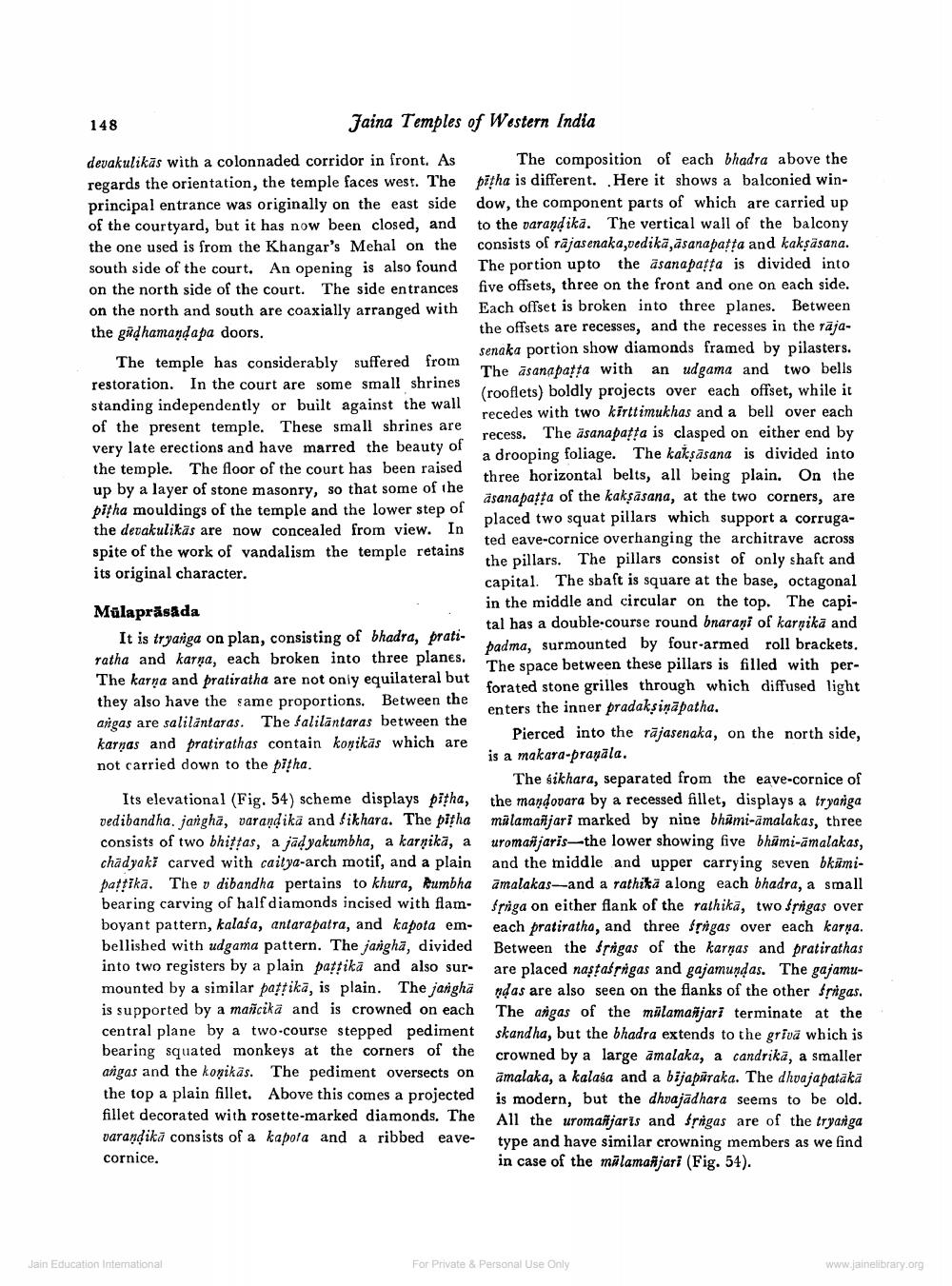________________
148
Jaina Temples of Western India
devakulikās with a colonnaded corridor in front. As The composition of each bhadra above the regards the orientation, the temple faces west. The pitha is different. Here it shows a balconied winprincipal entrance was originally on the east side dow, the component parts of which are carried up of the courtyard, but it has now been closed, and to the varandika. The vertical wall of the balcony the one used is from the Khangar's Mehal on the consists of rajas enaka,vedika,asanapatta and kaksäsana. south side of the court. An opening is also found the portion up to the asanapatta is divided into on the north side of the court. The side entrances five offsets, three on the front and one on each side. on the north and south are coaxially arranged with Each offset is broken into three planes. Between the gūdhamanda pa doors.
the offsets are recesses, and the recesses in the raja
senaka portion show diamonds framed by pilasters. The temple has considerably suffered from
The asanapatta with an udgama and two bells restoration. In the court are some small shrines
(rooflets) boldly projects over each offset, while it standing independently or built against the wall
recedes with two kirttimukhas and a bell over each of the present temple. These small shrines are
recess. The asanapatta is clasped on either end by very late erections and have marred the beauty of
a drooping foliage. The kaksāsana is divided into the temple. The floor of the court has been raised
three horizontal belts, all being plain. On the up by a layer of stone masonry, so that some of the
asanapatta of the kaksāsana, at the two corners, are pitha mouldings of the temple and the lower step of
placed two squat pillars which support a corrugathe devakulikäs are now concealed from view. In
ted eave-cornice overhanging the architrave across spite of the work of vandalism the temple retains
the pillars. The pillars consist of only shaft and its original character.
capital. The sbaft is square at the base, octagonal
in the middle and circular on the top. The capiMülaprāsada
tal has a double course round bnarani of karnika and It is tryaniga on plan, consisting of bhadra, prati
padma, surmounted by four-armed roll brackets. ratha and karya, each broken into three planes.
The space between these pillars is filled with perThe karya and pratiratha are not only equilateral but
forated stone grilles through which diffused light they also have the same proportions. Between the
enters the inner pradaksinapatha. angas are saliläntaras. The faliläntaras between the
Pierced into the rājasenaka, on the north side, karyas and pratirathas contain kopikäs which are
is a makara-praņāla. not carried down to the pitha.
The sikhara, separated from the eave-cornice of Its elevational (Fig. 54) scheme displays pitha, the mandovara by a recessed fillet, displays a tryanga vedibandha. jangha, varandika and Sikhara. The pitha malamañjari marked by nine bhūmi-āmalakas, three consists of two bhittas, a jād yakumbha, a karņika, a uromañjaris—the lower showing five bhūmi-āmalakas, chadyaki carved with caitya-arch motif, and a plain and the middle and upper carrying seven bkūnipattika. The v dibandha pertains to khura, Rumbha amalakas-and a rathikä along each bhadra, a small bearing carving of half diamonds incised with flam- briga on either flank of the rathika, two Sprigas over boyant pattern, kalaša, antara patra, and kapota em- each pratiratha, and three frigas over each karpa. bellished with udgama pattern. The jarigha, divided Between the sprigas of the karmas and pratirathas into two registers by a plain paffika and also sur. are placed nastassigas and gajamundas. The gajamumounted by a similar pattikā, is plain. The janghā ndas are also seen on the flanks of the other frigas. is supported by a marcika and is crowned on each The angas of the milamajari terminate at the central plane by a two-course stepped pediment skandha, but the bhadra extends to the grivä which is bearing squated monkeys at the corners of the crowned by a large amalaka, a candrika, a smaller angas and the koạikäs. The pediment oversects on amalaka, a kalaga and a bijapäraka. The dhuajapataka the top a plain fillet. Above this comes a projected
is modern, but the dhvajadhara seems to be old. fillet decorated with rosette-marked diamonds. The All the uromafjarts and Srigas are of the tryaniga varandika consists of a kapota and a ribbed eave- type and have similar crowning members as we find cornice.
in case of the malamafiljari (Fig. 54).
Jain Education International
For Private & Personal Use Only
www.jainelibrary.org




